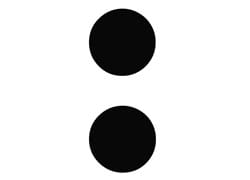 It is important that you know when to use a colon, as good writing in English will usually make use of this punctuation mark. A colon consists of two dots, one above the other, and it should not be confused with the semi-colon, which looks similar but has very different uses.
It is important that you know when to use a colon, as good writing in English will usually make use of this punctuation mark. A colon consists of two dots, one above the other, and it should not be confused with the semi-colon, which looks similar but has very different uses.
There are several rules that are useful when you are learning when to use a colon.
When to use a colon: Nine Simple Rules
 You should use a colon to introduce a list:
You should use a colon to introduce a list:
The dog loved four things: sleeping, playing, eating and chasing cats.
Two things kept me awake last night: stress and my husband’s snoring.
 You should use a colon before an explanation:
You should use a colon before an explanation:
Never work with children or animals: you never can predict how they may behave.
When I start to feel tired I take a break: it clears my mind.
 Use a colon when you want to place emphasis on the name or description of an item that follows a complete sentence:
Use a colon when you want to place emphasis on the name or description of an item that follows a complete sentence:
We have a name for people who don’t pull their weight at work: slacker.
He was so busy trying to impress the young girls that he didn’t notice who was standing right behind him: his wife.
 Use a colon to introduce a quotation of seven or more words that follows a complete sentence:
Use a colon to introduce a quotation of seven or more words that follows a complete sentence:
Miele (1993, p. 276) established the following: “The placebo effect … disappeared when behaviors were studied in this manner.”
After looking at the mess in the kitchen, Molly commented: “I hope you are not expecting me to clean this up.”
Take a look at our guide to using a colon before quotation marks to learn more.
 Use a colon to separate titles and subtitles:
Use a colon to separate titles and subtitles:
Colons: Do we Really Need Them?
Richard Nixon: The Tarnished President.
 When stating time, use a colon between the hour and the minute.
When stating time, use a colon between the hour and the minute.
10:30 p.m.
7:00 a.m.
3:00 p.m.
 When referring to passages in the Bible, use a colon between the chapter and the verse.
When referring to passages in the Bible, use a colon between the chapter and the verse.
John 11:35
Job 3:2
 When writing formal letters, use a colon after the salutation. When writing informal letters, a comma will suffice:
When writing formal letters, use a colon after the salutation. When writing informal letters, a comma will suffice:
To Whom it May Concern:
Dear Sir:
Dear Mr. Spiegler:
If you’re still confused as to when to use a colon, or think that you could benefit from the assistance of a professional editor, check out our online proofreading services now.
Want some more great advice on how to use punctuation? Take a look at our what punctuation mark should I use? cheat sheet.

Your article title is incorrect: you only gave eight rules. 😉